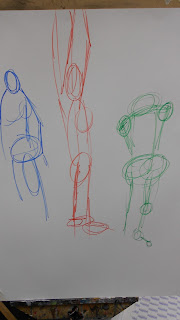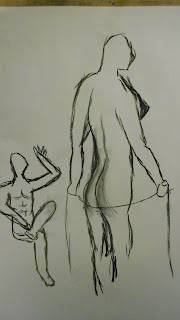Saturday, 30 March 2013
Unit 3: Film Review - Rope
 |
| Poster |
- Title Rope
- Directed byAlfred Hitchcock
- Release date 1948
- Running time 80 Minutes
Rope is a 1948 thriller film based on a play also titled Rope (1929) by Patrick Hamilton. The Play was adapted to a be feature film by Hume Cronyn and Arthur Laurents which then went on to be directed by Alfred Hitchcock and was to be the first of Hitchcock’s Technicolor films. Rope is famous for being filmed and edited together so it seems like one long continuous take rather than multiple shots edited together.
 |
| Figure one: Rope |
“Rope is not merely a stunt that is justified by the extraordinary
career that contains it, but one of the movies that makes that career extraordinary.” (Vincent Canby, June 3, 1984) Rope
has often been considered one of Hitchcock's most experimental movies because
of his choice to ignore many of the standard film techniques available in 1948.
This allowed him to have the long unbroken scenes in the film giving the viewer
the sense of it being one long take. Each shot ran continuously for up to ten
minutes without any interruption. It was filmed on a single set aside from the
opening street scene shown during the credits.
 |
| Figure two: The Arrogant |
The ingenious design of the set
helped greatly in the filming process allowing the long unbroken shots to
happen. The walls of the building were on rollers and could silently be moved
out of the way to make way for the camera and then be replaced when they were
to come back into the cameras view. A team of sound men and camera operators
kept the camera and microphones in constant motion as the actors kept to a
carefully choreographed set of cues. Prop men had to constantly move the
furniture and other props out of the way to allow the large Technicolor camera
to move in around the room for a more seamless experience, they then had to
ensure they were replaced in the correct location when the camera had made way. “The novelty of the picture is not in the
drama itself, it being a plainly deliberate and rather thin exercise in
suspense, but merely in the method which Mr. Hitchcock has used to stretch the
intended tension for the length of the little stunt.” (Bosley Crowther, August
17, 1948)
 |
| Figure three: The Guilty |
Rope has many suggestions
revolving around the subject of homosexuality, for instance, Brandon, who dominates his homosexual
lover, Philip, strangles David with an ordinary piece of Rope. David's only crime seems to be that he
is ordinary, for being engaged to his
fiancée, and is about to be married. It is OK to be “normal” but not “ordinary,”
because to be ordinary means to be boring and average in the two friends eyes. “Constrained by the enforced morality of the decency codes of the time,
the film cannot come out and say explicitly what is obvious to anyone watching
the film.” ( Paul McElligott, 18
October 2005) Rope was created in a time when any suggestions of
homosexuality were strictly forbidden, but the filming and script was done in
such a way that it didn’t actually commit any offence that could get Hitchcock
into trouble with the Production team.
Bibliography
Quotes
Quote 1: Vincent Canby, June 3, 1984 - http://www.nytimes.com/library/film/060384hitch-rope-reflection.html
Quote 2: Bosley Crowther, August 17, 1948 - http://www.nytimes.com/library/film/081748hitch-rope-review.html
Quote 3: Paul
McElligott 18 October 2005 - http://www.celluloidheroreviews.com/2005/10/18/rope-1948/
Images
Fig 2 – The arrogant: http://s3.imgimg.de/uploads/R35cd16c97jpg.jpg
Unit 3: Film Review - La Jetee
· Title La Jetee
· Directed by Chris Marker
· Release date 1962
· Running time 28 minutes
La Jetee, is a
French science fiction film from 1962, directed by Chris Marker.
It tells the story of a prisoner in the aftermath of the
Third World War, living in a destroyed, post-apocalyptic Paris where survivors
live underground in the Palais de Chaillot galleries. Scientists hope to use
time travel, to call past and future to the rescue of the present. They have
difficulty finding subjects who can mentally withstand the shock of time
travel, but eventually settle upon the prisoner, whose key to the past is a
vague but obsessive memory, from his pre-war childhood, of a woman he had seen
on the observation platform 'the jetty' at Orly Airport shortly before
witnessing a startling incident there. He had not understood exactly what
happened, but knew he had seen a man die.
After multiple attempts, he meets the woman from his memory, and they develop a relationship. After his successful passages to the past, the experimenters attempt to send him into the far future. He meets the advanced people of the future, and they give him a source of power strong enough to regenerate his own time.
With his mission accomplished, he learns that he is to now
be executed. The people of the future contact him and offer to help him escape
to their time, but he requests instead to be returned to the time of his
childhood, hoping to find the woman again. He is returned and does find her, on
the jetty at the airport. However, as he rushes to her, he notices one of the
jailers who has followed him and realises the jailer is about to kill him. In
his final moments, he comes to understand that the man’s death he witnessed as
a small child, at the start of the film was in fact his own.
This 27miniute film is composed entirely of still frames,
this adds to the narration and storytelling of the movie as the viewer is completely
focused on the image and the voice of the narrator during the movie, unlike modern
day Hollywood films that try to give you a ‘visual
overload’. ”La jetee is a remarkable
and unique experimental short that consists solely of still frames, narration,
music andsound effects” (Phil Hall, April
29, 2011)
Figure 3: The time
travler
The scene’s show casing the post-apocalyptic world are very
dark and don’t really show too much, “as
a result of us being emotionally imprisoned by the atmosphere of the film. This
touches on an almost gothic level of horror by rendering historical linearity
meaningless” (Dan Jardine, September 8, 2006) you get such a good sense of desperation
and despair from just the images alone that it adds a great deal to the story
narration and helps to keep viewers immersed in the narration. “La Jetée belongs to a genre that breeds
opportunity for elaborate vision and little thought; the film is responsibly
contrary to both assessments. Its strength is its simplification” (Rumsey
Taylor, 11 July 2004) La Jetee has been a very influential science fiction
film over the years, having been the key influence behind Terry Gilliam's 12 Monkeys (1995) from which it takes
several concepts directly from, La jetée.
Bibliography
Quote 1 ( Phil Hall): http://www.filmthreat.com/features/34818/
Quote 2 (Dan Jardine): http://djardine.blogspot.co.uk/2006/09/la-jetee-dan-briefly-interjects-and.html
Quote 3 (Rumsey
Taylor): http://djardine.blogspot.co.uk/2006/09/la-jetee-dan-briefly-interjects-and.html
Wednesday, 27 March 2013
Sunday, 24 March 2013
Saturday, 23 March 2013
Friday, 15 March 2013
Thursday, 14 March 2013
Monday, 11 March 2013
Sunday, 10 March 2013
Friday, 8 March 2013
Wednesday, 6 March 2013
Unit 4: The Fantastic Voyage - Art Direction
 |
| Takashi Murakami |
For my commission i would like to use an art style known as
"Superflat" that composes of using a mixture of 2d and 3d images or
models to create a unique and interesting art style. This art style was created
by Takashi Murakami and is a known art movement in Japanese culture.
Superflat Wikipedia: http://en.wikipedia.org/wiki/Superflat
Superflat Wikipedia: http://en.wikipedia.org/wiki/Superflat
The reason I am going with this style is because i want my
animation to be visually stunning to intise viewers to look at the screen and
keep them fixated on the animation, while also telling the story of the cell
cycle.
I can already imagine all of the cells actually being
characters and having faces and being generally a happy place to be.
I imagine the inner world of the cell cycle being a bit like
Beauty and the beast when all of the
items n the castle are a live and magical.
Images taken from:
murakami-versailles-5039192957_26ee6c83a3_b.jpg (768×1024)
Takashi-Murakami-Portrait-c-Guillaume-Ziccarelli.jpg (3744×5616)
google-doodle-4.jpg (520×319)
takashi-murakami-artwork-large-88399.jpg (581×600)
takashi-murakami-16860_1.jpg (800×565)
manga-takashi-murakami-versailles1.jpg (1024×683)
Screen-Shot-2012-12-19-at-12.01.39-AM.jpg (637×553)
Subscribe to:
Comments (Atom)
















































